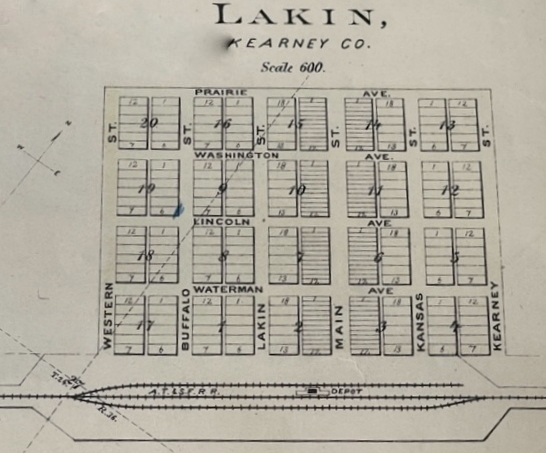John O’Loughlin’s arrival in the spring of 1873 signaled the beginning of a new town, but Lakin’s growth was relatively slow until 1879. Lakin’s first newspaper, the Lakin Eagle, arrived on the scene in May of that year. Four Lakin businesses advertised in the Eagle’s inaugural issue – O’Loughlin’s general merchandise; Harrison Burtch’s saloon; Gray & Jones groceries, hardware and lumber; and Potter Cason & Co. land agents. O’Loughlin had outgrown his dug-out trading post by this time, and carpenters were at work on a 30×50 two-story store building for Lakin’s founding father. The store sat next to his dug-out on the railroad right-of-way which became Lakin’s first business district. This strip of land, originally referred to as Main Street, began near Buffalo Street and ran about three blocks west. The Harvey House and railroad section house had been built here, and they were joined in the summer of 1879 by Joseph Dillon’s hardware store, George Bandall’s blacksmith shop and W.P. Loucks’ boarding house. In time, the strip became known as Front Street.
Cattle ranching was already a thriving business here, but the Eagle encouraged homesteaders to come here by promoting the agricultural possibilities. Pioneers were lured here by cheap land and the construction of irrigation ditches. In an area lacking in trees, the Eagle touted our natural building materials of sand stone, blue lime stone and potters clay. The Eagle predicted that Lakin would be the largest town in western Kansas in less than five years and claimed that the only thing holding Lakin back was the refusal of the Arkansas Valley Town Company to lay off the townsite into lots.
By the end of 1879, other businesses had set up shop in Lakin, but the Eagle had ceased operation. In the 1880 U.S. census, Kearney Township of Ford County had a population of 159, most of whom were living at Lakin either in the Harvey House, section house, shanties, dugouts or one of the few private residences that had been built. Aside of railroad and Harvey House employees, other occupations listed in the census included music teacher, grocer, carpenter, store clerk, druggist, harness maker, wild horse catcher, stone mason, lawyer, printer, cattlemen and laborers.
On March 7, 1882, Gilbert Bedell, an engineer from Larned, assisted by F.L. Pierce and Dayton Loucks, commenced a survey on Sec. 27, Twp. 24, Range 36 preparatory to the platting of Lakin. The original plat consisted of Blocks 1 through 20 with all east-west streets called avenues, and north-south roads called streets. Named for James Waterman who had come to Lakin in 1880 in the employ of the railroad, Waterman Avenue was the only street on the original plat dubbed for a local. Proprietors began moving their businesses from Front Street to the “new” Main Street, and O’Loughlin began digging a cellar on the northwest corner of Main and Waterman preparatory to moving his general store building there. Lakin’s new depot was completed in the spring of 1882 and sat back a small distance off South Main. In June, the Arkansas Valley Town Company requested that all those who hadn’t moved off the railroad right-of-way be removed at once.
 The Lakin Herald reported steady growth, “Our town is fast building up, every week adds another new house to our young city.” Businesses were also being erected on Waterman Avenue which was the main thoroughfare through Lakin prior to the construction of Highway 50. Lakin was becoming “civilized” with literary societies and a town orchestra. Herald Editor Joseph Dillon encouraged citizens to plant trees to beautify the town. “The planting of trees shows taste and refinement.”
The Lakin Herald reported steady growth, “Our town is fast building up, every week adds another new house to our young city.” Businesses were also being erected on Waterman Avenue which was the main thoroughfare through Lakin prior to the construction of Highway 50. Lakin was becoming “civilized” with literary societies and a town orchestra. Herald Editor Joseph Dillon encouraged citizens to plant trees to beautify the town. “The planting of trees shows taste and refinement.”
This area which was once labeled as the Great American Desert was promoted as the Garden of the West by land speculators. The extensive advertising campaign by the A,T&SF and the passing of the Homestead and Tree Claim Acts brought in settlers in ever-increasing numbers from 1883 to 1888. In 1883, construction began on Lakin’s town hall which was used not only for activities and meetings but also as a school and church. A $10,000 schoolhouse was opened in November 1886, and Lakin was designated as the temporary county seat of the newly organized Kearney County in March of 1888.
Lakin lost the county seat to neighboring Hartland in 1889. This loss, coupled with drought and nation-wide economic depression, led to a large number of settlers leaving the area. Portions of the supplemental plats that had been completed in 1885 and 1887 were vacated and returned to acreage to relieve the owners of paying city tax. Lakin’s boom had broke.

John O’Loughlin’s general store on the corner of Main and Waterman.
Sources: The Lakin Eagle from May 20, 1879 through Oct. 10, 1879; The Lakin Herald from June 24, 1881 through Dec. 28, 1883; Kansas State Historical Society; History of Kearny County Vol. I, and museum archives.
